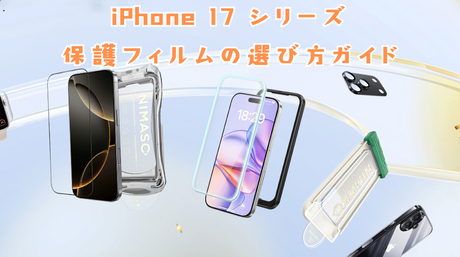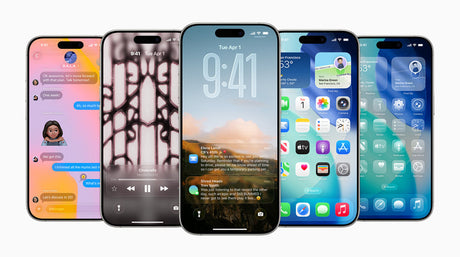Many people will buy accessories such as glass films and cases at the same time as they get new models such as the iPhone 14 and iPad Pro 2022. However, if you purchase the 2022 new iPhone - the iPhone 14 series (tentative) through pre-order, you won't have the iPhone 14 series (tentative) body, so how do you choose accessories such as glass films and cases?
Also, when you want to replace the glass film, which would you choose: the NIMASO 2.5D iPhone 13 glass film or the NIMASO 3D iPhone 13 glass film?

Additionally, I am confused by the various numbers written on the glass film packaging.
For those of you who have these concerns, today NIMASO will explain the key points to consider when selecting a glass film. We hope that it will be of some help to you.
What is 9H glass film?
All glass film manufacturers, including NIMASO, use a number and the letter "H" to indicate the hardness of the glass film. Everyone knows that this indicates the hardness of the glass film. However, the following problem may be a "secret" that only glass film manufacturers know.
-
Why is the hardness of glass film indicated as H?
-
How hard is 9H?
-
Is 9H the same as the Mohs hardness scale?
Now, NIMASO, the top display protection company, will explain it in an easy-to-understand way.

-
The key to glass film, which was created to protect the iPhone display, is hardness!! This is also the first point to consider when choosing a glass film.
The "9H" we commonly see is actually a pencil hardness.
Pencil hardness is expressed by how many H's of pencil you need to scratch to make a scratch. H is an abbreviation for Hard. The larger the number at the end of the H, the harder the lead is, with 9H being the hardest.
-
So why use pencil hardness for glass film?
This is where the "scratch test" comes in. The "scratch test" is also called the "pencil method." It is a method of measuring the hardness of a coating by pressing a pencil of known hardness against the coating under certain conditions.
As you know, the surface of glass film is coated with a coating (the most well-known is the oleophobic layer ) that performs various functions. Therefore, when talking about the hardness of glass film, it is not only the glass as the main material that is important, but also the hardness of the coating coated on the surface. As a result, the hardness of glass film is indicated by a number + H.
In other words, a glass film that is labeled as 9H will not be scratched even if it is scratched with a pencil with a hardness of 9H.
-
Next question: How hard is a 9H pencil hardness?

Source: Japan Coating Association website
This is the "Mohs hardness scale" that is used worldwide. Let's take a look at an image of the "Mohs hardness scale" together.
Diamond is known to be the hardest material, with a Mohs hardness of 10.
The glass film is made of tempered glass and is quite hard, but if you convert the 9H pencil hardness of the glass film to Mohs hardness, it is about 5 to 6. It's in the middle! It's quite hard and resistant to scratches. The Mohs hardness of a smartphone display is about 6, but it can be scratched by sand and gravel with a Mohs hardness of 7. In such cases, if you have a glass film, you can protect your smartphone display.
All NIMASO glass films are 9H, protecting your precious iPhone to the highest standard in the industry. In addition, NIMASO also offers a warranty service, so if it breaks, you can get a free replacement once. If you are worried about the warranty period expiring, you can also apply for a 6-month extended warranty .
What is the difference between 2D, 2.5D, and 3D?
Depending on whether or not the edges are rounded, glass films can be divided into 2D, 2.5D, 3D, etc.
But what is round edge processing? Round edge processing refers to polishing the edges of glass to make them round. It is often used for table tops and in stores to protect the safety of customers and children.
-
Without rounded edges - 2D glass film, the corners remain right angles.
-
Those with rounded edges are called 2.5D and 3D.

2.5D glass films have rounded edges at the corners and only protect the flat parts of the display. Although 2.5D glass films cannot completely cover the screen, they cover a much wider area than 2D, look beautiful after application, and have a good feel to the touch. Most importantly, 2.5D glass films do not interfere with the case. Therefore, most glass films currently on the market are 2.5D processed.
If you want to completely cover your display, choose a 3D glass film. 3D glass film protects your device three-dimensionally, even at the curved corners of your smartphone. However, we do not recommend 3D glass film for devices with right-angled corners like the iPhone 4.

The NIMASO full-surface protective glass film has a precisely rounded edge, which cushions impacts from the sides without any snagging, and has a pleasantly smooth texture. The silicone self-absorbent layer prevents air from getting in, and by using the included guide frame, anyone can easily apply the film without it slipping out of place on the main body.
If there is any bulging, you can remove it by using an air release spatula or wrapping a cloth around your finger and pushing it out little by little. It protects the display up to the edge without interfering with the smartphone case.
We recommend NIMASO glass film for all previous iPhone models, including the iPhone 13, iPhone SE 3rd generation/2nd generation, and iPhone 14 (tentative name)!
Is there really a glass film with 98% transmittance?
The higher the transmittance value, the better, but commercially available glass films have a transmittance of 90%, which can beautifully reproduce the vividness of the screen.

NIMASO glossy glass film has a high transmittance of 93% and a thin design, so you can always enjoy a beautiful screen and smooth operation.
Among the rumors about the iPhone 14 collected by NIMASO, there is information that the iPhone 14 Pro model will adopt a 120Hz ProMotion display. This means that the iPhone 14 Pro model can display videos more smoothly. By applying the high-transmittance NIMASO glass film, you can protect the smartphone body and enjoy a more beautiful screen at the same time.
We have introduced a variety of options, so please choose the one that best suits your needs.









